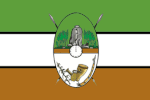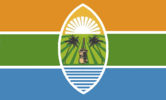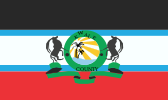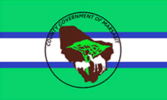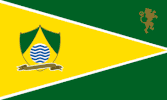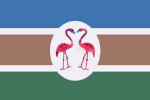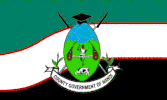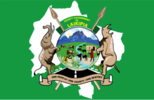
The North Eastern Province is one of the former provinces in Kenya. It has a land area of 127,358.5 km2, with its capital at Garissa. Previously known as the Northern Frontier District (NFD), the North Eastern Province territory was carved out of the present-day southern Somalia during the colonial period.

Mombasa County is one of the 47 counties of Kenya. Its capital is Mombasa. In terms of economic it is second after Nairobi. Initially it was one of the former districts of Kenya but in 2013 it was reconstituted as a county, on the same boundaries. It is the smallest county in Kenya, covering an area of 229.7 km2 excluding 65 km2 of water mass. The county is situated in the south eastern part of the former Coast Province. It borders Kilifi County to the north, Kwale County to the south west and the Indian Ocean to the east. Administratively, the county is divided into seven divisions, eighteen locations and thirty sub-locations.
Wundanyi is a town in the Taita-Taveta County of Kenya. Other urban centres in the county include Voi, Taveta and Mwatate.

Taita–Taveta County previously known as Taita Taveta District is a county of Kenya. It lies approximately 140 km northwest of Mombasa and 380 km southeast of Nairobi. Taita Taveta County is located approximately 360 km southeast of Nairobi and 200 km northwest of Mombasa, and is a port and major gateway to the United Republic of Tanzania through Taveta town. The County headquarters are located in Mwatate sub county, which is one of the six counties in the Jumuiya ya Kaunti za Pwani regional economic bloc. Major towns include Voi, Taveta, Mwatate and Wundanyi
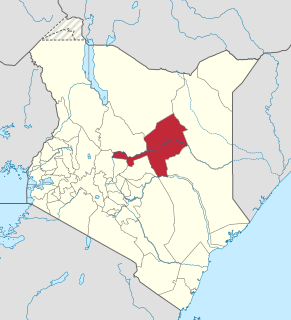
Isiolo County is a county in the former Eastern Province of Kenya. Its population is 268,002 and its capital and largest city is Isiolo. Isiolo is also the Least Populated County in Kenya. Isiolo County is to be the first county to be developed as part of the Kenya Vision 2030 program. Other upcoming urban centres are: Garbatulla, Modogashe, Kinna, Merti and Oldonyiro.

Local authorities in Kenya are the bodies controlling local governance in urban areas in Kenya.

Wajir County is a county in the former North Eastern Province of Kenya. Its capital and largest town is Wajir. The county has a population of 720,000 and an area of 55,840.6 km2 (21,560.2 sq mi). The county is bordered to the north by Ethiopia, to the northeast by Mandera County, to the east by Somalia, to the south by Garissa County, to the west by Isiolo County and to the northwest by Marsabit County. The county has six constituencies: eldas, Tarbaj, Wajir North, Wajir West, Wajir East, and Wajir South.

The districts of Kenya were divided into 262 divisions (matarafa). Divisions of Kenya were further subdivided into locations. Today's counties of Kenya are based on the merging of some of the districts on this list and since the divisions are one level under the districts they are now the sub-counties. This is because Kenya recently changed its constitution and 47 Counties emerged. Here are the divisions listed below, by district :
From late 2011 to 2014, Kenya experienced an upsurge in violent terrorist attacks. Kenyan government officials asserted that many of the murders and blasts were carried out by al-Shabaab in retaliation for Operation Linda Nchi, a coordinated military mission between the Somalian military and Kenyan military that began in October 2011, when troops from Kenya crossed the border into the conflict zones of southern Somalia. According to Kenyan security experts, the bulk of the attacks were increasingly carried out by radicalized Kenyan youth who were hired for the purpose. Kenya security officials also indicated that they were part of death squads, which carried out many of the killings under the orders of a government security council. By mid-2014, the cumulative attacks began affecting Kenya's tourism industry, as Western nations issued travel warnings to their citizens.

Sub-counties are the decentralised units through which county governments of Kenya will provide functions and services. Except for the parts which fall under urban areas, sub-counties will coincide with the constituencies created under article 89 of the Constitution of Kenya. Sub-counties will be headed by a sub-county administrator, appointed by a County Public Service Board.
The list shows coat of arms for the forty-seven counties of Kenya. Some counties adopted the coat of arms of the defunct district governments. Other coat of arms adopted in the year after the first county governments came into power which was between March 4, 2013 to the same date on 2014. As of Dec 17th 2014 not all county assemblies have passed the design of the county coat of arms. It is expected that all counties will adopt their own flags soon.

Martin Kivuva Musonde,, is the Roman Catholic Archbishop of the Archdiocese of Mombasa, effective 9 December 2014. He previously served as the Bishop of the Roman Catholic Diocese of Machakos from 2003 until 2014.
On 2 April 2015, gunmen stormed the Garissa University College in Garissa, Kenya, killing 148 people, and injuring 79 or more. The militant group and Al-Qaeda spinoff Al-Shabaab, which the gunmen claimed to be from, took responsibility for the attack. The gunmen took over 700 students hostage, freeing Muslims and killing those who identified as Christians. The siege ended the same day, when all four of the attackers were killed. Five men were later arrested in connection with the attack, and a bounty was placed for the arrest of a suspected organizer.
The Nationwide League is a domestic Kenyan rugby union competition. Full members of the Kenya Rugby Union that do not participate in the top tier Kenya Cup are entitled to participate in the league. It operates in a system of promotion and relegation with the Kenya Cup. Matches are played on Saturday afternoons, usually before fixtures in the Kenya Cup.
The Garissa–Nuno–Modogashe–Wajir Road is a road in Kenya, connecting the towns of Garissa, Nuno, Modogashe and Wajir.
The Kenya Schools and Colleges Drama Festival is a series of student theatre competitions in Kenya, held from January to April each year, advancing through local, county and regional stages to the National Drama Festival. Students from primary schools to colleges take part, with total annual participation of roughly five million students, making it the biggest educational theatre event in Africa.
The Anglican dioceses of Mombasa are the Anglican presence in and around Mombasa and south-east Kenya; they are part of the Anglican Church of Kenya. The remaining dioceses of the Church are in the areas of Maseno, of Mount Kenya, and of Nakuru.
Granton Graham Samboja is a Kenyan politician and media executive who served as the second governor of Taita Taveta County from 2017 to 2022. He is a member of the Jubilee Party of Kenya. Samboja capitalized on his background in the media and his links with President Uhuru Kenyatta to get into politics. His education background remains the subject of controversy.
Isiolo–Mandera Road, is a road in Kenya. It is a major transport route linking north-central Kenya to Kenya's northeast. The counties that the road traverses are generally arid, and have hitherto been undeserved. This road project is the largest and most expensive infrastructure project in northeastern Kenya since the country became independent in 1963.










